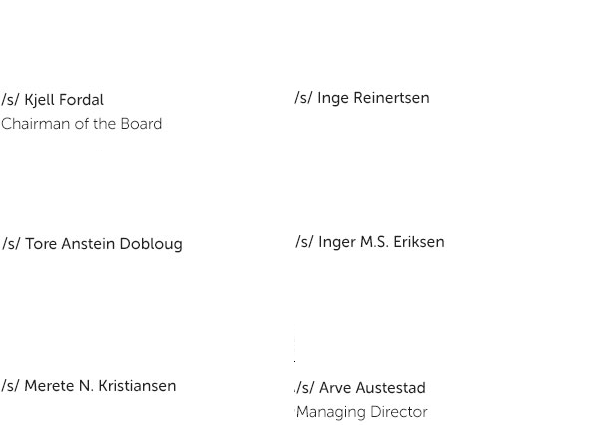Boligkreditt Annual Report 2017
Statement of the board of directors
Cover pool and outstanding covered bonds
Boligkreditt’s cover pool consists of residential mortgages and liquid, highly rated assets (substitute assets) as well as derivatives hedging liabilities in a foreign currency and/or at fixed rates.
A change has taken place with regards to the reporting of overcollateralization at year-end 2017. The derivatives, which were previously presented with the bonds they hedge, are now part of the cover assets and repurchased own bonds are no longer netted with outstanding debt. This shift in presentation has reduced the calculated o/c percentage as reflected in these financial statements compared to previous quarters. The chart below illustrates the cover pool balances, and the resulting o/c is calculated to be 6.4 per cent 1.
1 See also note 26 in the 2017 annual accounts for further information
The amount of liquid assets varies over time and the variation is solely a result of the Issuer’s liquidity risk management (and regulatory requirements), whereby upcoming redemptions are refinanced early (up to 12 months) with proceeds held as liquid assets (please see the investor reports for details on the composition of liquid assets).
Key figures
| Q4 2017 | Q3 2017 | Q2 2017 | Q1 2017 | Q4 2016 | |
|---|---|---|---|---|---|
| Weighted Average Current LTV (%) | 52,4 % | 51,0 % | 49,2 % | 49,7 % | 51,1 % |
| Weighted Average Original LTV (%) | 59,8 % | 59,9 % | 59,8 % | 59,6 % | 59,4 % |
| Average Loan Balance (NOK) | 1 386 865 | 1 374 953 | 1 349 074 | 1 340 039 | 1 322 732 |
| Number of Mortgages in Pool | 127 927 | 127 895 | 128 475 | 130 920 | 131 743 |
| Pct. of non first-lien mortgages | 0,0 % | 0,0 % | 0,0 % | 0,0 % | 0,0 % |
| Overcollateralization | 106,4 % | 107,7 % | 108,7 % | 111,2 % | 108,8 % |
Key developments in 2017
SpareBank 1 Boligkreditt issued two EUR benchmark covered bonds in 2017 with maturities of 5 (January 2017) and 7 years (June 2017) for a total issuance of Euro 2 billion.
The bonds were well received in the market. Norwegian krone issuance amounted to 8.2 billion kroner. An inaugural GBP covered bond issuance also took place, a £ 500 million, 5 year floating rate note. In early 2018 the Company issued an inaugural green covered bond in EUR (1 billion, 7 year maturity).
The residential lending volume has increased moderately as expected by approximately 1.8 per cent over 2017. Overall, lending growth in the four largest Alliance banks was 5.6 per cent for the first three quarters, mostly driven by mortgage lending to households as opposed to corporate and small/medium sized enterprise lending. The smaller growth rate of the cover pool is a reflection of the growth in deposits in the Company’s owner banks, other alternative funding sources than covered bonds and the fact that one bank, SpareBank 1 SR-Bank has continued to withdraw mortgage loans from the cover pool at times when this is permitted (when previously issued covered bonds mature). The share of SR-Bank’s loans in the cover pool fell to just below 8 per cent at the end of 2017, from above 13 per cent at the beginning of the year. Other than the slower growth in cover pool volume, there are no consequences of this development and no other Boligkreditt owner or originating Alliance bank is reducing its transferred mortgage volume.
In the market for the Company’s bonds the credit spreads have generally contracted with the market. The two issuances referenced above were both issued at zero basis points above EUR mid-swap levels, while towards the end of the year spreads were trading in single digit negative territory.
Boligkreditt is well capitalized with a capital coverage ratio of 16.68 per cent (Pillar 1) measured against a total capital requirement of 15.5 per cent (including an expanded countercyclical capital buffer), while the add-on required Pillar 2 requirement is set at 0.8 per cent core capital. Total Tier 1 capital is 14.53 and core equity capital 12.95 per cent, the latter against a requirement for core capital (incl. Pillar 2) of 12.8 per cent. It is the Company’s policy to maintain a capital ratio at or slightly above the regulatory requirement. Additional core capital is injected by the owner banks when required, while additional CET 1 and Tier 2 capital is issued in the Norwegian domestic market.
SpareBank 1 Boligkreditt has a negative result for 2017 as a whole at 239 million kroner pre-tax. This is entirely due to the change in basis swap valuation adjustments, an accounting requirement, which does not impact cash flows and earnings, and reverse to zero over time (at the final swap maturity). The pre-tax change in the basis swap valuation adjustment was 389 million kroner. Generally, when basis swap spreads narrow compared to the level originally entered into, there is a charge for the valuation adjustment and vice versa. The portfolio of all basis swaps are shown as a 190 million kroner liability in the accounts at year-end 2017. Basis swaps are used to hedge currency risk in bonds issued in other currencies than NOK. Dividends are calculated and paid to the owner banks by adding back a charge, or deducting a gain, which arises from this non-cash accounting charge.
During the third quarter the Company decided to discontinue the rating process with Fitch Ratings. The rationale for this was both to reduce costs and increase operational efficiency. Fitch affirmed the AAA rating (stable outlook) for the covered bonds at the time of the ratings withdrawal.
Nature and development of the Company’s business
SpareBank 1 Boligkreditt AS is a credit institution licensed by the Norwegian Financial Supervisory Authority (Finanstilsynet) and is operated according to the legislation for covered bond issuers in Norway which is included in the law regarding financial enterprises (“Finansforetaksloven”) chapter 11, section II and the detailed regulations thereof.
The purpose of the Company is to provide funding for the owners by buying residential mortgage loans with a loan-to-value (“LTV”) of up to 75 per cent and financing these primarily through the issuance of covered bonds. The Company which is based in Stavanger, is owned by banks which are members of the SpareBank 1 Alliance. A comprehensive agreement is signed with each of the banks in the SpareBank 1 Alliance which are selling mortgages to the Company regarding the purchasing process and the obligations which the banks owe the Company and its mortgage customers (“Transfer and Servicing Agreement”, “TSA”). The Company’s operating model is to pay out to the parent banks who sell mortgages to the Company the margin earned during the course of the year (commissions to the parent banks). These commissions are, similar to interest expense, deducted in the financial accounts to calculate net income.
The Company’s issuances of covered bonds mainly take place under the EUR 25,000,000,000 Global Medium Term Covered Note Programme (GMTCN Programme). This Programme was updated on June 6, 2017 and is available on the Company's home page: https://spabol.sparebank1.no.
One or more credit ratings from international rating agencies are important in order to be able to issue covered bonds. The Company have procured the services of Moody’s Ratings Service to evaluate the credit quality of the issuances under the GMTCN Programme. The bond ratings are Aaa from Moody’s.
Annual accounts
The annual accounts have been prepared in accordance with the International Reporting Standards (IFRS) as adopted by the EU and published by the International Reporting Standards Board (IASB).
The Board views the accounts as presented to be a true representation of SpareBank 1 Boligkreditt’s operations and financial position at the end of the year. Numbers in brackets refer to the previous year for comparison.
The total balance sheet at year-end 2017 amounts to 262 (252) billion kroner. The increase is largely due to bond issues ahead of maturities in 2018, with proceeds held as liquid assets until repayment dates according to the Issuers liquidity risk management policies. The Company had in 2017 net interest income of 426 (411) million kroner, deducting also commissions paid to the parent banks to arrive at net interest income. The cost of operations for the year was 34.4 (35.3) million kroner including depreciation and amortization. No additional amounts have been charged as loan loss provisions (write offs) in 2017 beyond the approximately 8 million kroner which has been reserved from previous years. No actual loan losses have occurred since the Company commenced operations. This produces an operating result of negative 239 million kroner (negative 146) before tax. The operating result includes a loss due to basis swap valuation adjustments of approximately 389 million kroner. Basis swap valuation adjustments are non-cash, temporary effects which are reversed over time until maturity of the swaps.
Lending to customers amounted to 178 (174) billion kroner as of 31.12.17. Even though some mortgage loans have been sold back to the Company’s parent banks during the year as a part of normal operations, there has been an expected though moderate increase of mortgage loans during the year. The Company’s own liquid assets as of 31.12.17 were approximately 34 (26) billion kroner. Liquid assets are cash and highly rated, highly liquid bonds which are held as a function of upcoming bond maturities up to 12 months ahead in time.
Risk aspects
SpareBank 1 Boligkreditt as an issuer of covered bonds is subject to strict rules regarding its exposure to credit, market, and liquidity risks. This fact, and the aim of the maintenance of the Moody’s Aaa rating, means that the Company is subject to low levels of risk and places strong emphasis on risk control.
Credit Risk is defined as the risk that losses can occur as a consequence of that customers and others do not have the ability or willingness to meet their obligations to SpareBank 1 Boligkreditt. Because the Company buys residential mortgages within 75% of the value of the objects on which the mortgages are secured, the Board of Directors conclude that the credit risk is lower than for banks in general.
Market risk is defined as the risk of losses due to changes in market rates, i.e. interest rates, exchange rates and the prices of financial instruments. At the end of the year SpareBank 1 Boligkreditt AS had issued bonds for approximately 135 billion kroner in EUR, 18 billion kroner in USD, 5.5 billion in GBP and 0.3 billion kroner in Swedish kroner, at exchange rates at year-end. However, all borrowing and investments with a fixed rate and all borrowing and investments in a foreign currency, have been hedged by financial currency- and/or interest rate swap agreements or through natural hedges. The collective cash flow therefore matches borrowings in Norwegian kroner with floating rate conditions (NIBOR 3 months). The Company receives collateral from its counterparties in derivative agreements according to certain criteria.
SpareBank 1 Boligkreditt AS owns deposits, bills and bonds at year-end for a total of NOK 57.3 (50.6) billion kroner, whereof 23.6 (24.3) billion kroner is collateral received from counterparties in derivatives transactions, and are thus reserved for the return of such collateral. The bonds held are mainly Nordic covered bonds and German supra sovereign and agencies (German agencies guaranteed by the German government) with a triple-A rating from Fitch, Moody's or S&P. Deposits are placed in banks with a minimum rating of at least A/A2.
The Company had as of 31.12.2017 only moderate interest rate risk and immaterial amounts of currency risk.
Liquidity risk is defined as the risk that the Company is not able to meet its obligations at maturity or to be able to finance the purchase of loans at normal terms and conditions. Liquidity risk is managed based upon a liquidity strategy approved by the Board. According to the strategy, SpareBank 1 Boligkreditt AS shall maintain a material liquidity reserve with a minimum size of covering all maturities within 6 months and 50 per cent of all maturities between 6 and 12 months. Additionally the Company shall at any point in time be able to meet its interest payments, including derivatives, which come due in the next three months under a scenario where no interest payments are received from the loan portfolio. SpareBank 1 Boligkreditt AS’s liquidity situation is good.
Operational risk is defined as risk of loss due to error or neglect in transaction execution, weakness in the internal control, or information technology systems breakdowns. Reputational, legal, ethical and competency risks are also elements of operational risk. The risk is assessed to be moderate.
The Company spends much time identifying, measuring, managing and following up central areas of risk in such a way that this contributes to meeting the strategic goals. The notes 21 to 25 in the 2017 annual accounts provides further information.
Employees and the working environment
SpareBank 1 Boligkreditt had eight employees as of 31.12.2017.
The Company employs six males and two females. SpareBank 1 Boligkreditt AS has a Transfer and Servicing Agreement with each shareholder bank which is handling the customer contact and servicing the mortgage portfolio on behalf of the Company. In addition, the Company purchases a significant amount of its support functions from SpareBank 1 SR-Bank ASA, e.g. accounting, HR and IT functions, as well as finance related back-office functions. This is related to the Company’s physical co-location at the premises of SR-Bank. Several banks in the Alliance could also alternatively perform these services.
The working environment is characterised as good and there is no pollution of the physical environment. There has been 7.1 per cent employee absence recorded in 2017 due to sickness. No workplace accidents which might have resulted in property and/or damage to any persons have occurred or been reported during the year.
The Board consists of five persons of which three are male and two are female. SpareBank 1 Boligkreditt AS strives to achieve an even distribution between the genders in recruiting for the staff and the Board.
At the establishment of SpareBank 1 Næringskreditt AS which represents a similar type of business activity to that of SpareBank 1 Boligkreditt AS, it was decided that the two companies will have identical staffing. Of the eight full time employees which in 2017 have been employed in SpareBank 1 Boligkreditt and Næringskreditt AS, 1.6 full time equivalents have been allocated to SpareBank 1 Næringskreditt AS. The Boards of the two companies have joint meetings, where the members associated with one of the companies take the role of observers when matters of the other Company are discussed.
Corporate governance
SpareBank 1 Boligkreditt’s principles for corporate governance is based on the Norwegian accounting law and regulations and the Norwegian Code of Practice for Corporate Governance.
The Board of Directors has appointed an audit committee which evaluates the Accounts inclusive of the Notes to the Accounts. The Board of Directors reviews the financial reporting processes in order to contribute to a culture which maintains a focus on quality and accuracy of this work. Boligkreditt seeks to deliver through its financial accounting relevant and timely information which can be compared over time to constituents in the SpareBank 1 Alliance, regulatory authorities and participants in the capital markets. The Board evaluates and approves Management’s proposed annual and quarterly financial accounts.
Boligkreditt maintains an administration which is suitable for the purposes, activities and extent of the business. The Management routinely evaluates internal procedures and policies for risk and financial reporting including measuring the results and effectiveness of the procedures and policies. Any breaches in the policy and procedures are reported continuously to the Board of Directors. Management is also responsible for following up and implementing actions, recommendations and new rules from the regulatory authorities.
The Company publishes its Corporate Governance policies in a document available on the Company’s website www.spabol.no. With regards to that the Company has a single purpose and that the shares are not freely tradeable nor listed on an exchange it is the Company’s opinion that any deviations to the policies are immaterial.
Shareholders
According to the Articles of Association 2 “The shares can only be owned by banks under contract with the Company for managing the Company’s lending funds.” Entering into such agreements is decided by the Board or the General Meeting.
Neither the Company nor employees own shares in the Company. A shareholders agreement which all shareholders and the Company are parties to, stipulates that the Company’s shares will be reallocated at least annually and in relation to the mortgage volume transferred to the Company by each shareholder. The shareholders are obliged to vote for any possibly private placements to new banks that have transferred mortgages to the Company. In case of a rights issue, the shareholders are obliged to subscribe shares according to its share of the shareholdings. The Company is not party to agreements which come into force, are amended or are terminated as a result of a takeover bid.
Social responsibility
SpareBank 1 Boligkreditt is a specialized issuer of covered bonds and has, despite the size of its balance sheet, a very limited activity with only eight full time employees.
The nature of the business consists solely of buying residential mortgage loans from its shareholder banks in the SpareBank 1 Alliance, and to finance this activity by issuing covered bonds. The banks in the SpareBank 1 Alliance are regular banks in the Norwegian market with an array of activities, including lending to businesses and households. The parent banks set lending policies, service and handle all customer activity (including the customers whose mortgage loans have qualified for and been sold to the Company). While the Company is legally entitled to set its own terms for the mortgages it owns, this is in practice done by the parent banks, who, in conjunction with the Company have agreed a set of qualifying criteria for which loans may be sold to the Company. Because all customer facing activity, including lending policies, are set by the parent banks a reference is made to the annual accounts and the websites of the banks for a closer description of the social responsibility and the broader spectrum of ESG in SpareBank 1 banks.
The Company supports and encourages increased ESG disclosures and initiatives within SpareBank 1 and has been an active part of the overall development of the strategy by issuing a green covered bond in January 2018. In addition to this, the Company adopts the same set of ESG values and goals as the parent banks (see in particular the Green Bond Framework on the Company’s website for further references to this). In the area of mortgage finance in general the originating banks are obligated by Norwegian regulation (boliglånsforskriften) to analyse the sustainability of mortgage debt that borrowers are seeking and both to not approve and provide advice to customers who are seeking debt levels which may be or become unsustainable.
Future prospects of the Company
The Company has a portfolio of residential mortgage lending with an average loan to value (LTV) of approximately 50 per cent and no loans are in default.
The maximum allowable level for a mortgage in a cover pool is 75 per cent LTV, with amounts above that level not being eligible as a cover pool asset.
Residential real estate prices in Norway, and especially in the capital of Oslo, have been depreciating since the spring of 2017. Over the full year 2017 the Norwegian real estate index is down 2.1 per cent, while in Oslo it is down 6.2 per cent. The correction seems to be effected by tighter regulations for banks on the mortgage market (amended regulations became effective in January 2017), which specifically address the previous (2015-16) strong price appreciation in the capital. Also, building activity has been high recently in the larger Oslo market (construction responding to higher valuations and strong demand), which means that there are now more residential units on offer, weighing on prices. With transaction prices now declining, sentiment probably has an additive effect in curbing or postponing natural demand, and thus increases the units currently for sale, which reinforces the price drop. However, latest figures show that real estate prices firmed again in January 2018, and also in the capital.
SpareBank 1 Boligkreditt’s portfolio is well diversified throughout the major city regions in all of Norway, which do develop with a lesser degree of correlation from time to time. In addition, banks in the SpareBank 1 Alliance must keep reserves of eligible (cover pool qualified) mortgages in order to continue to add more mortgages to the cover pool and thus obtain covered bond funding. The reserves at the individual bank level must be sufficient to cope with an overnight hypothetical price depreciation of real estate prices of 30 per cent. Measured at any one point in time, the mortgage reserve before the 30 per cent price decline must be able to replenish the cover pool for individual loans as needed and absorb the decrease in market values (increase in LTVs) for the reserve loans so that the reserve is no less than zero after the theoretical shift.
Due to the special characteristics and restrictions for loans to become part of the cover pool, the high degree of diversification of the pool and the continued strength of the Norwegian economy, as well as prudent lending practices (and mortgage lending regulations) in place, the prospects for the Company are continuing to be good and stable. The Board also base this conclusion on the low LTVs of the mortgages, no defaults or arrears, a strong history and institutional framework in Norway for loan performance, as well as the low unemployment environment.
Macroeconomic development:2
On a year over year basis, the Norwegian mainland economy expanded by 2.9 per cent in the first quarter, and 1.9 per cent in the third, with a small contraction of 0.2 per cent in the second quarter (fourth quarter and full year figures are available in mid-February, but the forecast after three quarter is for 1.9 per cent growth for the full year). Taken together, the quarters represent a good broad-based performance in the mainland economy driven by business investments, exports and consumption increases. Especially business services, trade in goods and tourism contributed. The unemployment rate is now 4.1 per cent (January 2018), down from 4.9 per cent at the peak of the oil driven cycle in the summer of 2016. The labour market is therefore clearly improving. It is to some extent important that the oil price has increased from the lows of 2015-16. The Norwegian energy sector has over the previous two to three years reduced costs significantly and new investment projects in the sector are viable to a higher degree at the current oil price. Jobs are created in many sectors across industries in Norway, which have benefitted from the relatively weak Norwegian currency (and low interest rates). However, the unemployment rate improvement is partially also explained by a reduced labour force participation rate, which is now 69.7 per cent of the population, down from just above 71 per cent at the end of 2014.
1 Macroeconomic projections have been sourced from Statistics Norway as of November 28, 2017.
Economic outlook:
Internationally, both the OECD area and the Eurozone are growing at better rates than in recent years and this positively impacts the very open and trade orientated Norwegian economy. The Norwegian krone has been weak and has not recovered with the increasing oil price in the second half of 2017, which is surprising given the usually higher positive correlation. In the short to medium term and absent a krone strengthening this should add to growth via the trade balance, where both oil and gas but also other goods and services (around 50 per cent of total exports) are increasing. Other growth impulses are now coming from an expected increase in oil sector investments (oil price recovery), which are expected to increase by over seven per cent in 2018. General business investments on the mainland are also increasing in several sectors, as is household consumption, with increasing real wages.
At the same time the government fiscal stimulus is neutral in 2018 (no increase in the volume of krone spending) and is likely to reverse in later years as there is a general political consensus that the contribution from the sovereign wealth fund to the government budget should decline. As discussed further above, house prices have been correcting in 2017 and the expectation is for residential construction activity to level out and decline, and this should detract from growth.
Summarized the forecast for the next few years are as follows for a few key indicators:
| Forecast (%) | 2016 | 2017 | 2018 | 2019 | 2020 |
|---|---|---|---|---|---|
| Mainland GDP growth | 1,0 | 1,9 | 2,5 | 2,4 | 2,3 |
| Unemployment rate | 4,7 | 4,2 | 3,9 | 3,8 | 3,7 |
| CPI growth | 3,6 | 1,8 | 1,9 | 2,0 | 2,0 |
| Annual wage growth | 1,7 | 2,4 | 2,9 | 3,3 | 3,9 |
| Current account surplus to GDP | 3,9 | 6,5 | 6,4 | 6,6 | 6,6 |
Source: Statistics Norway (SSB) Nov 28, 2017
The Board of Directors affirms its conviction that the financial accounts present a correct and complete picture of the Company’s operations and financial position for 2017. The financial accounts including notes are produced under the assumption of a going concern. 72.3 million kroner of the annual net income will be distributed as a dividend to the shareholders (basis swap adjustments do not affect distributable income). This corresponds to 1.10 kroner per share (rounded).
There have been no incidents of a material nature after year-end which are expected to impact the annual accounts for 2017.
Stavanger, 31. December 2017 / 8. February 2018
The Board of Directors of SpareBank 1 Boligkreditt AS

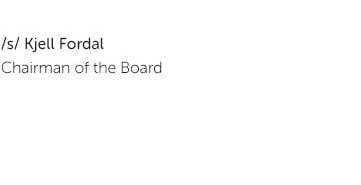

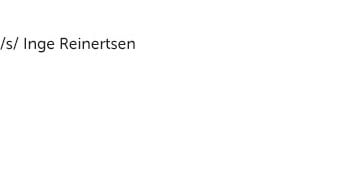

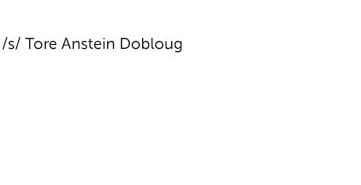
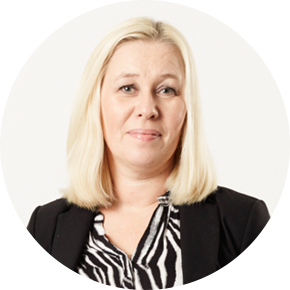


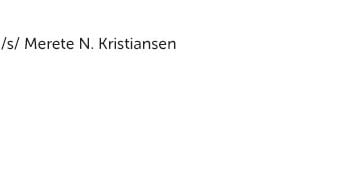

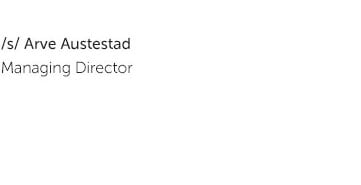
SpareBank 1 Boligkreditt AS
- Statement of the members of the board and the chief executive officer
The Board and the chief executive officer have today reviewed and approved the financial accounts for 2017 for SpareBank 1 Boligkreditt AS. The annual accounts have been prepared in accordance with the International Financial Reporting Standards (IFRS), as adopted by the EU.
To the best knowledge of the board and the chief executive officer the accounts have been prepared in accordance with applicable accounting standards and give a true and fair view of the assets, liabilities, financial position and profit or loss of the company taken as a whole as of 31.12.17.
The board of directors and the chief executive officer declare to the best of their knowledge that the annual report gives a true and fair view of the development and performance of the business of the Company, as well as a description of the principal risks and uncertainties facing the Company.
Stavanger, 31. December 2017 / 8. February 2018
The Board of Directors of SpareBank 1 Boligkreditt AS
